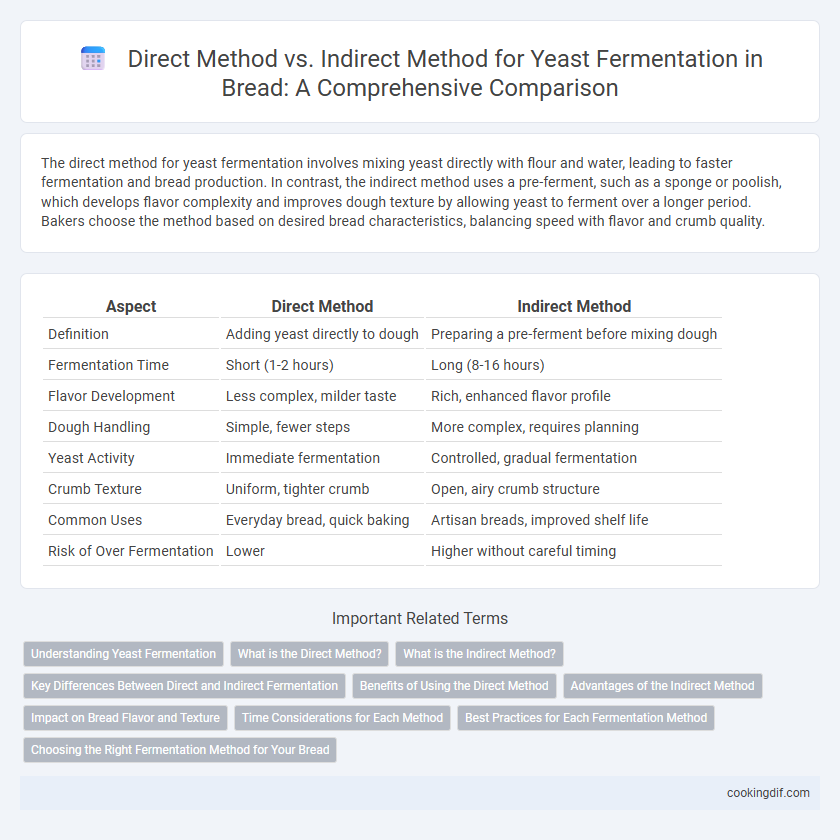The direct method for yeast fermentation involves mixing yeast directly with flour and water, leading to faster fermentation and bread production. In contrast, the indirect method uses a pre-ferment, such as a sponge or poolish, which develops flavor complexity and improves dough texture by allowing yeast to ferment over a longer period. Bakers choose the method based on desired bread characteristics, balancing speed with flavor and crumb quality.
Table of Comparison
| Aspect | Direct Method | Indirect Method |
|---|---|---|
| Definition | Adding yeast directly to dough | Preparing a pre-ferment before mixing dough |
| Fermentation Time | Short (1-2 hours) | Long (8-16 hours) |
| Flavor Development | Less complex, milder taste | Rich, enhanced flavor profile |
| Dough Handling | Simple, fewer steps | More complex, requires planning |
| Yeast Activity | Immediate fermentation | Controlled, gradual fermentation |
| Crumb Texture | Uniform, tighter crumb | Open, airy crumb structure |
| Common Uses | Everyday bread, quick baking | Artisan breads, improved shelf life |
| Risk of Over Fermentation | Lower | Higher without careful timing |
Understanding Yeast Fermentation
The direct method of yeast fermentation involves adding active yeast directly to the dough, ensuring rapid fermentation and predictable rise times. In contrast, the indirect method uses a preferment or sponge, allowing yeast to ferment sugars gradually, enhancing flavor complexity and improving texture. Understanding these methods helps bakers control the fermentation rate, optimize yeast activity, and produce bread with desired crumb structure and taste.
What is the Direct Method?
The Direct Method of yeast fermentation involves mixing yeast directly with flour, water, and other ingredients at the start of dough preparation, enabling rapid fermentation. This approach accelerates dough rising and reduces overall preparation time, producing bread with a uniform crumb and mild flavor. Bakers favor the Direct Method for its simplicity and efficiency in creating consistent, everyday bread products.
What is the Indirect Method?
The indirect method for yeast fermentation involves creating a pre-ferment, such as a sponge or poolish, by mixing a portion of the flour, water, and yeast and allowing it to ferment before combining with the remaining ingredients. This technique enhances flavor development, improves dough strength, and increases fermentation activity compared to the direct method where all ingredients are mixed simultaneously. Bakers use the indirect method to achieve a more complex taste and better texture in bread by extending fermentation time and optimizing yeast performance.
Key Differences Between Direct and Indirect Fermentation
Direct fermentation uses fresh or active dry yeast added straight to the dough, resulting in faster fermentation and a shorter proofing time. Indirect fermentation involves a pre-ferment, such as a sponge or poolish, which develops flavor and improves dough strength over a longer fermentation period. The indirect method enhances yeast activity gradually, producing richer aroma and better texture compared to the quicker but less flavorful direct method.
Benefits of Using the Direct Method
The direct method of yeast fermentation in bread making accelerates the process by mixing all ingredients simultaneously, leading to faster dough development and reduced production time. This approach enhances yeast activity due to immediate sugar availability, resulting in consistent fermentation and uniform crumb structure. Bakers benefit from simplified workflows and lower operational costs, making the direct method ideal for large-scale commercial bread production.
Advantages of the Indirect Method
The indirect method of yeast fermentation in bread-making offers superior flavor development due to extended fermentation times, allowing organic acids and alcohols to form and enhance taste complexity. This method improves dough texture and crumb structure by promoting better gluten development and gas retention. Additionally, the indirect method provides greater flexibility for bakers to control fermentation stages, resulting in more consistent and high-quality bread products.
Impact on Bread Flavor and Texture
The direct method of yeast fermentation produces bread with a milder flavor and softer texture due to the rapid fermentation process that limits complex flavor development. In contrast, the indirect method, involving a preferment or sponge, enhances flavor complexity and creates a chewier texture by allowing longer fermentation and Maillard reaction precursors to develop. Bakers often choose the indirect method for artisanal breads to achieve a richer taste profile and improved crust characteristics.
Time Considerations for Each Method
The direct method for yeast fermentation in bread making typically requires less time, as yeast is added directly to the dough, allowing quicker fermentation and faster production. The indirect method involves a pre-ferment stage, such as a sponge or poolish, extending the fermentation time but enhancing flavor development and dough strength. Bakers choose between these methods based on desired fermentation duration and the balance between speed and bread quality.
Best Practices for Each Fermentation Method
The direct method for yeast fermentation in bread baking involves mixing yeast directly with flour and water, promoting faster fermentation and consistent dough rise, best suited for quick bread production. The indirect method includes preparing a preferment or sponge, allowing controlled yeast activity that enhances flavor development and dough strength, ideal for artisan breads. Optimal practice for the direct method emphasizes precise yeast measurement and temperature control, while the indirect method benefits from extended fermentation times and hydration management to maximize gluten structure and aroma.
Choosing the Right Fermentation Method for Your Bread
Choosing the right fermentation method for bread significantly impacts flavor and texture; the direct method involves mixing all ingredients at once, leading to faster fermentation and a milder taste, ideal for quick baking. The indirect method uses a pre-ferment like a sponge or poolish, which enhances flavor complexity and improves crumb structure through longer fermentation. Bakers seeking pronounced flavor and better shelf life often prefer the indirect method, while those prioritizing efficiency and simplicity typically select the direct method.
Direct method vs indirect method for yeast fermentation Infographic

 cookingdif.com
cookingdif.com